Redis实战-商户查询缓存
# Redis实战-商户查询缓存
缓存时数据交换的缓冲区,是存储数据的临时地方,一般读写性能较高
# 1、添加商户缓存
基本思路:
- 查询redis缓存,命中直接返回
- 未命中查询数据库
- 数据库查询失败,则直接返回错误信息
- 查询成功,先存入redis再返回数据
controller层
@GetMapping("/{id}")
public Result queryShopById(@PathVariable("id") Long id) {
return shopService.queryById(id);
}
2
3
4
service层:
@Service
public class ShopServiceImpl extends ServiceImpl<ShopMapper, Shop> implements IShopService {
private final StringRedisTemplate stringRedisTemplate;
@Autowired
public ShopServiceImpl(StringRedisTemplate stringRedisTemplate) {
this.stringRedisTemplate = stringRedisTemplate;
}
@Override
public Result queryById(Long id) {
String key =CACHE_SHOP_KEY + id;
//redis查询缓存
String cacheShop = stringRedisTemplate.opsForValue().get(key);
//判断命中
if (StrUtil.isNotBlank(cacheShop)) {
//命中,返回
Shop shop = JSONUtil.toBean(cacheShop, Shop.class);
return Result.ok(shop);
}
//未命中,查询数据库
Shop shop=getById(id);
//数据库查询是否存在
if(shop==null){
//不存在,返回错误
return Result.fail("店铺不存在");
}
//存在,返回并写入redis
stringRedisTemplate.opsForValue().set(key,JSONUtil.toJsonStr(shop));
return Result.ok(shop);
}
}
2
3
4
5
6
7
8
9
10
11
12
13
14
15
16
17
18
19
20
21
22
23
24
25
26
27
28
29
30
31
# 1.1 商户类型缓存查询
service层:
这里直接用String存储List集合(JSON),其实可以用redis的List类型来存储,但是这样会复杂很多
service层:
@Override
public Result queryViaCache() {
//查询redis
String jsonShopType = stringRedisTemplate.opsForValue().get(CACHE_SHOPTYPE_KEY);
//命中直接返回
if(jsonShopType!=null){
List<ShopType> list = JSONUtil.toList(jsonShopType, ShopType.class);
return Result.ok(list);
}
//没有命中去查询数据库
List<ShopType> typeList = query().orderByAsc("sort").list();
//数据库没找到直接返回
if(typeList.isEmpty()){
return Result.fail("数据库查询失败");
}
//找到了就先存入redis
String jsonShopTypeDTO = JSONUtil.toJsonStr(typeList);
stringRedisTemplate.opsForValue().set(CACHE_SHOPTYPE_KEY,jsonShopTypeDTO);
return Result.ok(typeList);
}
}
2
3
4
5
6
7
8
9
10
11
12
13
14
15
16
17
18
19
20
21
redis存List类型示例一:
public static void main(String[] args) {
List<Student> studentsAll = new ArrayList<>();
StringRedisTemplate stringRedisTemplate = new StringRedisTemplate();
List<Student> students = new ArrayList<>();
for (Student students : students) {
stringRedisTemplate.opsForList().rightPush("student", JSON.toJSONString(students));
}
List<String> studentList = stringRedisTemplate.opsForList()
.range("student", 0, -1);
// 将redis中的数据转换为对象集合
for (String studentString : studentList) {
studentsAll.add(BeanUtils.copyProperties(studentString,Student.class));
}
}
2
3
4
5
6
7
8
9
10
11
12
13
14
示例二:
public class JsonUtils{
private static final ObjectMapper om = createObjectMapper();
public static ObjectMapper createObjectMapper() {
ObjectMapper om = new ObjectMapper();
// 反序列化时,忽略Javabean中不存在的属性,而不是抛出异常
om.configure(DeserializationFeature.FAIL_ON_UNKNOWN_PROPERTIES, false);
// 忽略入参没有任何属性导致的序列化报错
om.configure(SerializationFeature.FAIL_ON_EMPTY_BEANS,false);
return om;
}
public static <T> List<T> toListOfObject(String json, Class<T> clazz, ObjectMapper om) {
try {
@SuppressWarnings("unchecked") Class<T[]> arrayClass = (Class<T[]>) Class
.forName("[L" + clazz.getName() + ";");
return Lists.newArrayList(om.readValue(json, arrayClass));
} catch (IOException | ClassNotFoundException e) {
log.error("json={}, clazz={}", json, clazz, e);
throw new JsonException(e);
}
}
}
2
3
4
5
6
7
8
9
10
11
12
13
14
15
16
17
18
19
20
21
22
23
24
25
# 2、缓存更新解决方案
redis会在内存不够时自动清除一部分,或者设置过期时间,还可以主动设规则,称为主动更新
写在前面:主动更新的最佳实现方案
- 读操作
- 缓存命中直接返回
- 未命中则查询数据库,并写入缓存,加入超时时间
- 写操作
- 先写数据库,再删除缓存
- 要确保数据库和缓存操作的原子性,
# 2.1 Cache Aside Pattern(大部分时候使用该方案)
由缓存的调用者,在更新数据库的同时更新缓存
问题
删除缓存还是更新缓存?
- 更新缓存:每次更新数据库都要更新缓存,无效操作多(假设写一百次,但是只有一两个数据需要读,这时会浪费缓存空间)
- 删除缓存:更新数据库的时候让缓存失效,查询时再更新缓存(通常选择该方案)
如何保证数据库和缓存的操作同时成功和失败(原子性)?
- 单体系统:将缓存和数据科技操作放在一个事务里
- 分布式系统:利用TCC等分布式事务方案
先操作缓存还是先操作数据库?(线程安全问题)
先删缓存,再操作数据库。
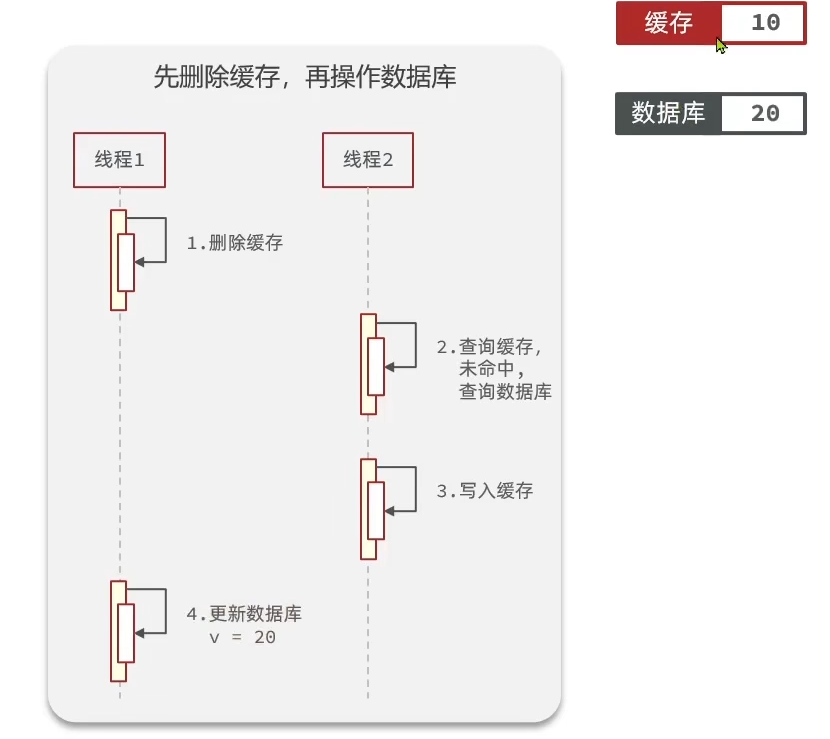
并行运行时,因为没有加锁,所以容易出现,更新还未完成,但是另一个线程,把缓存先更新了,然后第一个线程才更新完数据库,这样数据库的数据和缓存的数据是不一致的。
先操作数据库,再删缓存。(主要选该方案,发生概率低)
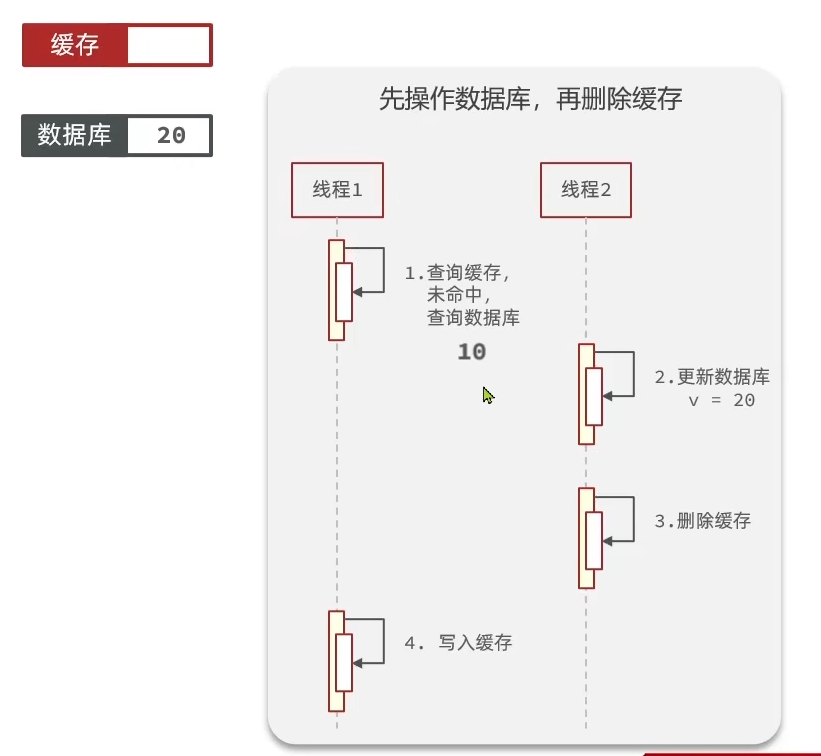
如果第一个线程查询缓存的时候,缓存因为过期之类的问题,导致未命中,这时会去查询数据库,在查询数据库的同时,线程二去更新数据库了,那么线程一已经查到的值是落后的,这时线程一会去写入缓存,这时缓存和数据库数据又不一致了
需要在每次写入缓存时加一个超时线程作为兜底,几乎可以解决方案二的线程安全问题,因为方案二触发问题的条件多,概率低
# 2.2 Read/Write Through Pattern
缓存和数据库整合为同一个服务,由服务来维护一致性。调用者无需关心缓存一致性的问题。
# 2.3 Write Behind Caching Pattern
调用者只操作缓存,由其他线程异步的将缓存数据持久化到数据库,保证一致
# 3、更新缓存案例
小插曲:没有在jdbc链接里写useUnicode=true&characterEncoding=utf8导致从mybatisplus传入数据的时候乱码
查询(其实就加了个过期时间):
@Override
public Result queryById(Long id) {
String key =CACHE_SHOP_KEY + id;
//redis查询缓存
String cacheShop = stringRedisTemplate.opsForValue().get(key);
//判断命中
if (StrUtil.isNotBlank(cacheShop)) {
//命中,返回
Shop shop = JSONUtil.toBean(cacheShop, Shop.class);
return Result.ok(shop);
}
//未命中,查询数据库
Shop shop=getById(id);
//数据库查询是否存在
if(shop==null){
//不存在,返回错误
return Result.fail("店铺不存在");
}
//存在,返回并写入redis
stringRedisTemplate.opsForValue().set(key,JSONUtil.toJsonStr(shop), Duration.ofMinutes(CACHE_SHOP_TTL));
return Result.ok(shop);
}
2
3
4
5
6
7
8
9
10
11
12
13
14
15
16
17
18
19
20
21
22
更新:
/**
* 主动更新,更新商品操作,同时删除Redis缓存
*/
@Override
@Transactional //记得设置事务回滚,假设数据库设置成功了,缓存删除没成功,就能回滚
public Result updateShop(Shop shop) {
//判断id是否存在
if(shop.getId()==null){
return Result.fail("店铺id不能为空 ");
}
//先更新数据库
updateById(shop);
//删除缓存
stringRedisTemplate.delete(CACHE_SHOP_KEY + shop.getId());
return Result.ok();
}
2
3
4
5
6
7
8
9
10
11
12
13
14
15
16
# 4、缓存穿透
缓存穿透是指客户端请求的数据在缓存和数据库中都不存在,这样缓存永远不会生效,这些请求都会打到数据库
解决方案
- 缓存空对象
- 哪怕请求的数据不存在,也缓存一个null,这样就不会直接到达数据库
- 缺点
- 造成额外的内存消耗(可以设置短TTL,这样就可以减轻内存消耗问题)
- 可能造成数据短期不一致(因为有TTL,所以哪怕数据已经存在了,也不能及时返回)
- 布隆过滤(准确度不能保证百分百,但是绝对不会在有数据的情况不放行)
- 在请求redis之前先请求布隆过滤器,如果值为空则直接拒绝请求,有则放行
- 优点:内存占用少
- 缺点:实现较复杂(好在redis自带BitMap),存在误判可能
- 缓存空对象
主动防御
- 增加id复杂度,避免被猜测
- 做好数据的基础格式校验(比如id=0,不可能存在)
- 加强用户权限校验
- 热点参数做限流
# 4.1 实际案例
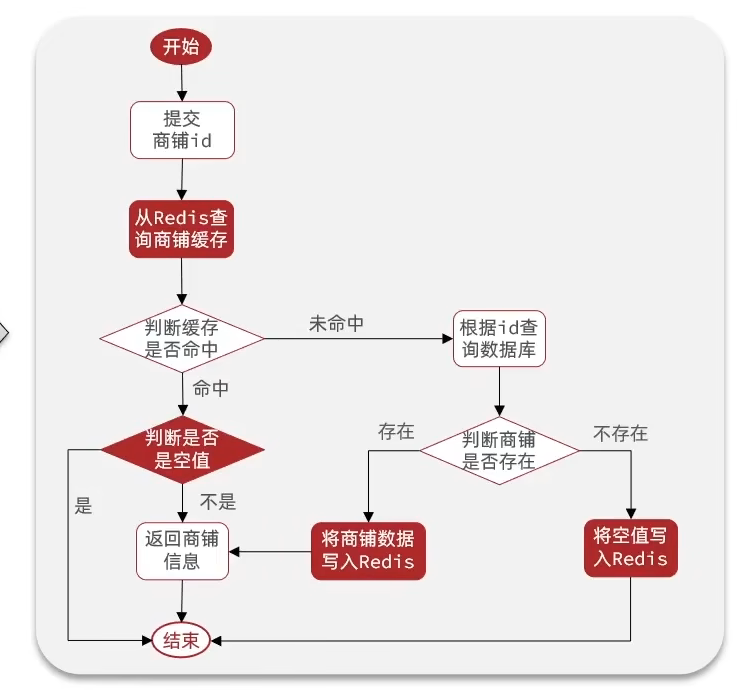
# 4.1.1 缓存空对象
hutool的StrUtil.isNotBlank()在字符串为换行符\t,空值null,空字符串""时都返回false,所以使用这个方法时,我们要再加一个判断去专门返回空对象
if(StrUtil.isBlank(cacheShop)){
return Result.fail("数据为空");
}
2
3
# 5、缓存雪崩
同一时间段大量缓存key失效或者reids服务宕机,大量请求到达数据库,带来巨大压力
解决方案:
- 给不同keyTTL添加随机值
- 利用redis集群提高服务可用性
- 给缓存业务添加降级限流策略
- 给业务添加多级缓存(nginx缓存,浏览器缓存)
# 6、缓存击穿
部分key过期导致的问题,这部分key是热点访问key,在高并发访问业务下并且缓存重建业务较复杂的情况下
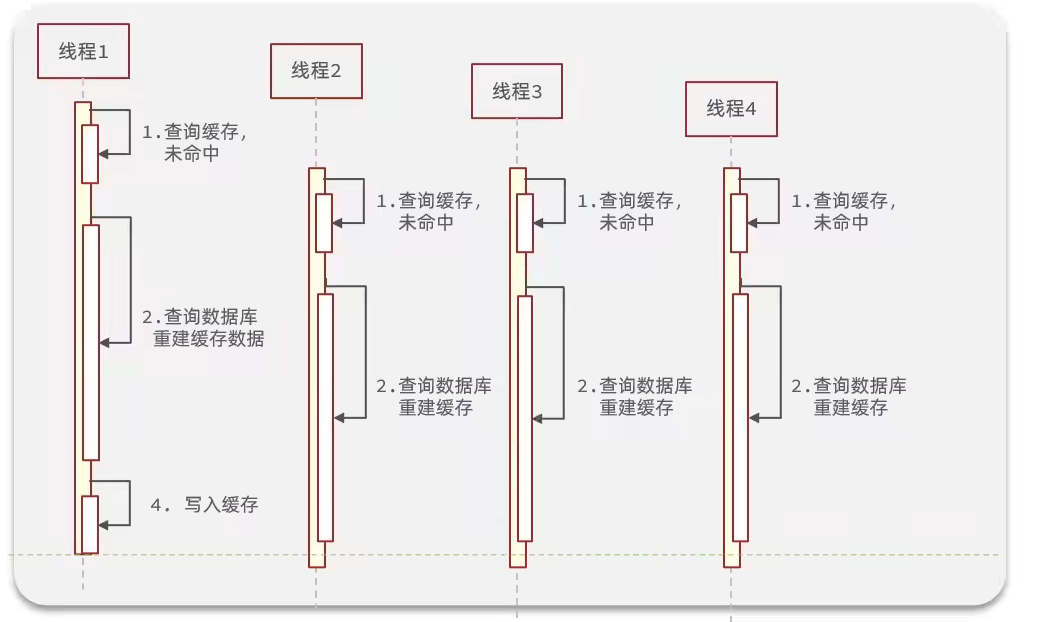
如图所示,重建缓存的时间很长,这个时候又有很多用户访问,每一个用户在缓存成功写入前都会发送一个请求,这个时候就会发生缓存击穿。
解决方案:
# 6.1 互斥锁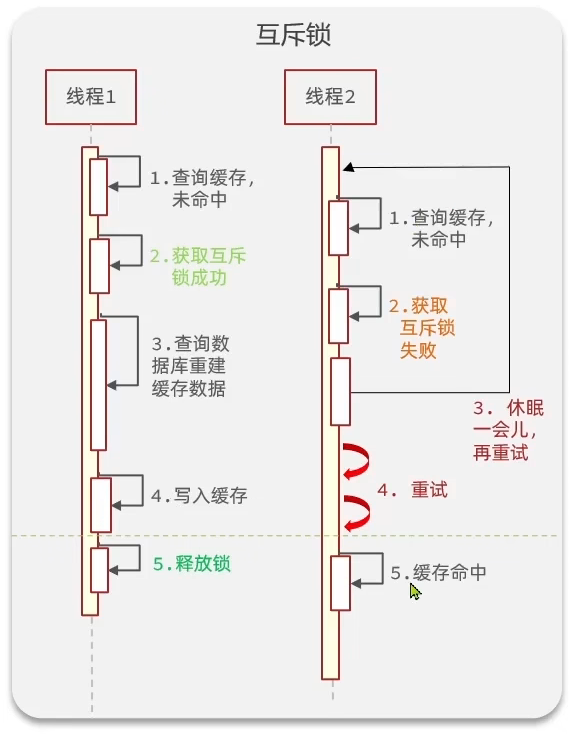
如图所示,建立了一个互斥锁,当第一个线程获取互斥锁成功,开始重建缓存的时间里,第二个线程访问的时候获取互斥锁失败,这个时候就设置它阻塞一小会,然后再让他获取信息,直到缓存命中
# 6.2 逻辑过期
因为设置了TTL所以会失效,那不设置不就完了吗,当然还是需要一个类似的东西来保证它能过期,一般在数据里加上expire字段记录过期时间,一般是当前时间戳加上类似三十分钟的过期时间
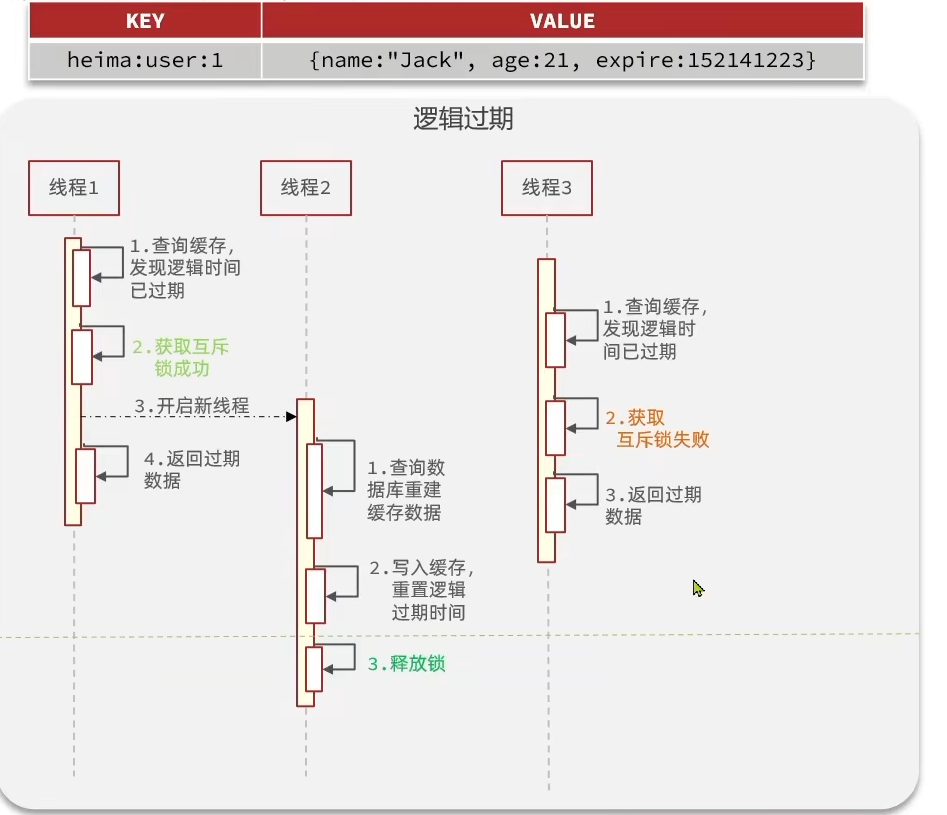
如图线程1如果发现逻辑时间已过期,则先获取互斥锁,然后开启一个新的子线程来帮他处理数据库重建缓存,然后写入缓存,重置过期时间,线程1在构建期间可以直接返回过期数据,注意:过期数据不等于失效数据,可能和过期前一模一样,但是逻辑上需要他过期重建,所以直接返回没有问题,其他线程也会去获取互斥锁,此时会发现有线程在修改,就可以直接拿过期数据返回
# 6.3 两者优缺点
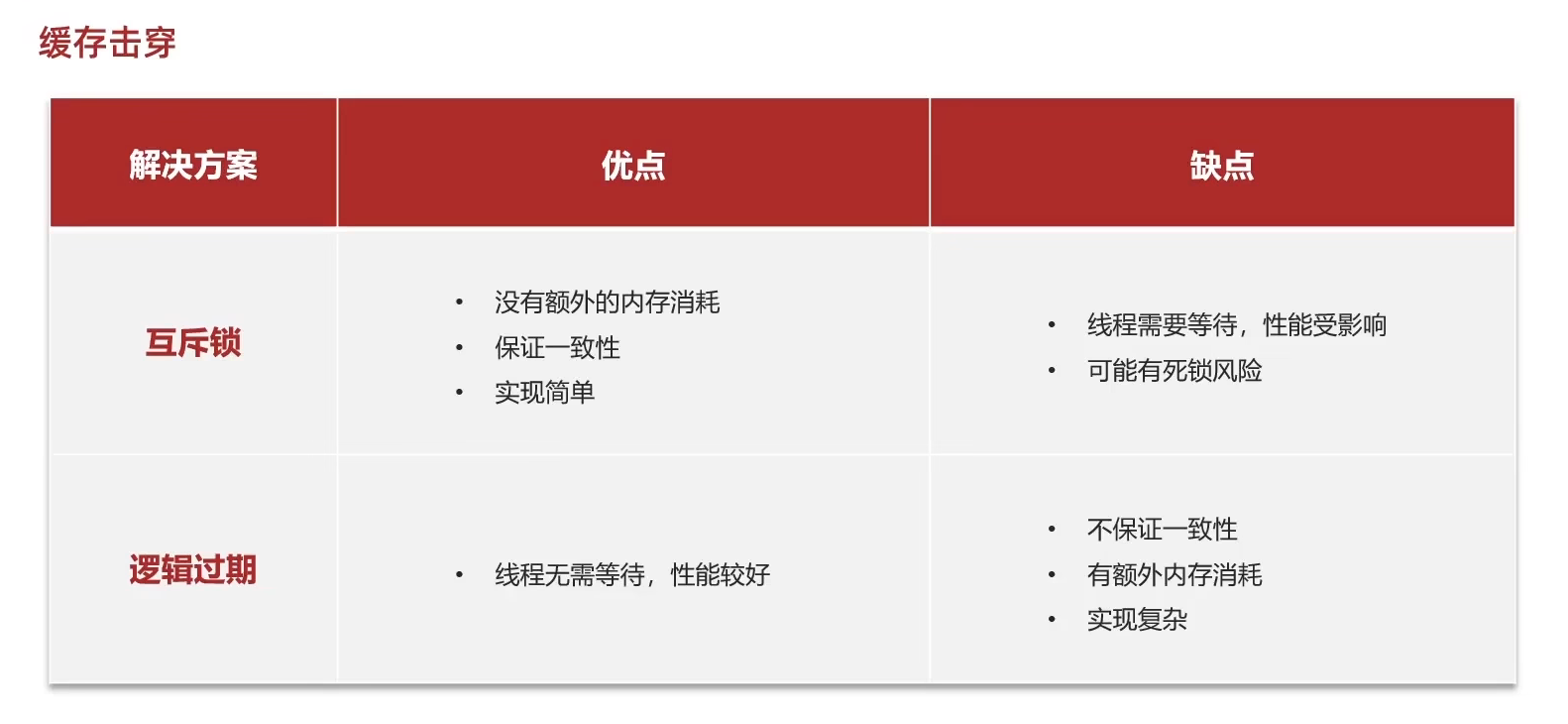
# 6.4 案例解决
# 6.4.1 互斥锁解决
流程图:
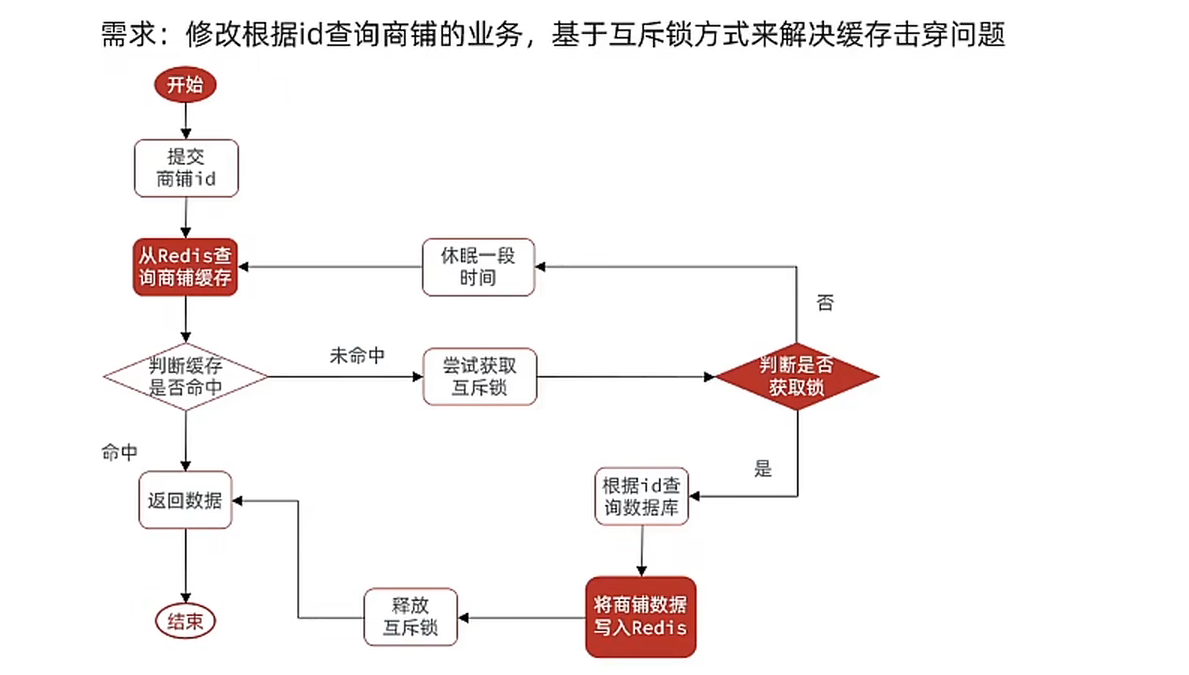
redis中的String类型有一个命令
setnx key value只有第一次赋值可以成功,非常适合用来当互斥锁还有分布式锁,但是如果程序出问题了,锁一直没有被释放,那么就会出问题,所以一般会设置一个短的有效期,比如10s
代码:
public Shop queryWithMutex(Long id){
String key =CACHE_SHOP_KEY + id;
//redis查询缓存
String cacheShop = stringRedisTemplate.opsForValue().get(key);
//判断命中
if (StrUtil.isNotBlank(cacheShop)) {
//命中,返回
return JSONUtil.toBean(cacheShop, Shop.class);
}
//判断空对象
if(cacheShop!=null){
return null;
}
//实现缓存重建
try {
//获取互斥锁
boolean isLock = tryLock(LOCK_SHOP_KEY + id);
//判断是否获取成功
if(!isLock){
//失败,休眠并重试
Thread.sleep(50);
//递归直到有返回值,记得返回回去
return queryWithMutex(id);
}
//成功,查询数据库
Shop shop=getById(id);
Thread.sleep(200);
//数据库查询是否存在
if(shop==null){
//不存在,返回错误
//同时把空值写入缓存
stringRedisTemplate.opsForValue().set(key,"",Duration.ofMinutes(CACHE_NULL_TTL));
return null;
}
//存在,返回并写入redis
stringRedisTemplate.opsForValue().set(key,JSONUtil.toJsonStr(shop), Duration.ofMinutes(CACHE_SHOP_TTL));
return shop;
}catch (InterruptedException e) {
throw new RuntimeException(e);
}finally {
//一定要执行一遍释放锁
unlock(LOCK_SHOP_KEY + id);
}
}
2
3
4
5
6
7
8
9
10
11
12
13
14
15
16
17
18
19
20
21
22
23
24
25
26
27
28
29
30
31
32
33
34
35
36
37
38
39
40
41
42
43
44
45
互斥锁方法:
/**
* 互斥锁上锁
* @param key
* @return 互斥锁是否存在
*/
private boolean tryLock(String key){
Boolean b = stringRedisTemplate.opsForValue().setIfAbsent(key, "1", Duration.ofSeconds(10L));
return BooleanUtil.isTrue(b);
}
/**
* 互斥锁释放
* @param key
*/
private void unlock(String key){
stringRedisTemplate.delete(key);
}
2
3
4
5
6
7
8
9
10
11
12
13
14
15
16
# 6.4.2 逻辑过期
流程图:
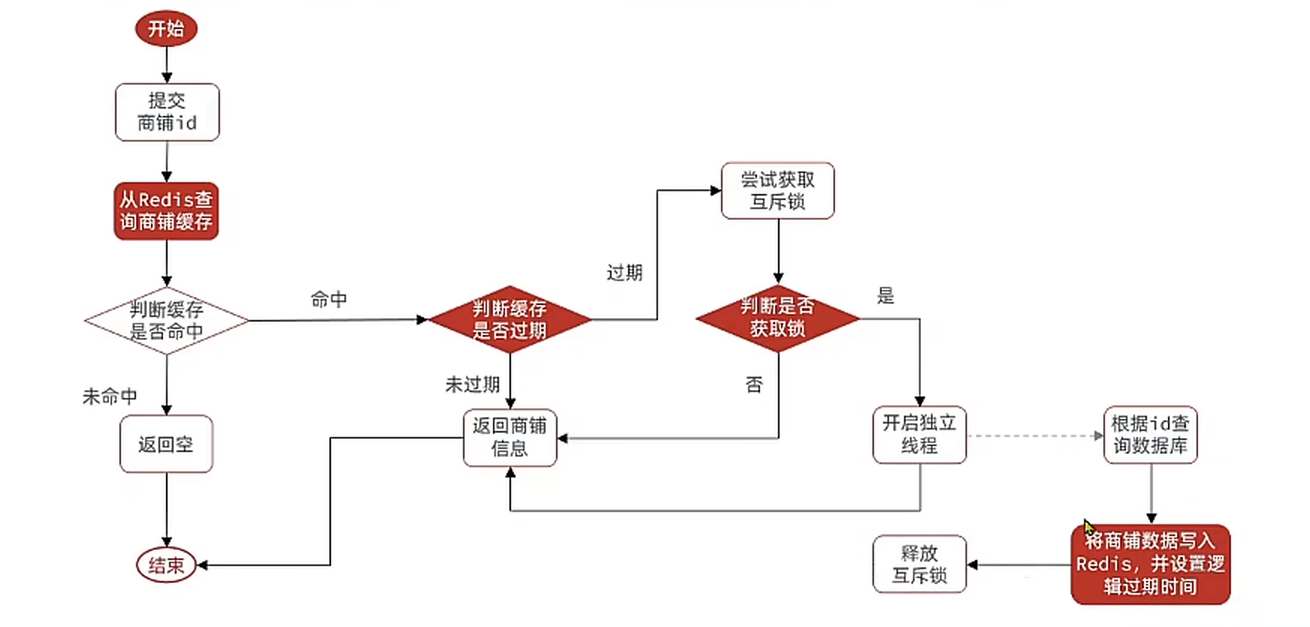
可以先建一个类,用来存到Redis里
@Data
public class RedisData {
private LocalDateTime expireTime;
private Object data;
}
2
3
4
5
功能实现
private static final ExecutorService CACHE_REBUILD_EXECUTOR= Executors.newFixedThreadPool(100);
/**
* 缓存击穿解决(逻辑过期)
* @param id
* @return
*/
public Shop queryWithLogicalExpire(Long id){
String key =CACHE_SHOP_KEY + id;
//redis查询缓存
String cacheShop = stringRedisTemplate.opsForValue().get(key);
//判断是否能命中缓存
if(StrUtil.isBlank(cacheShop)){
//未命中,返回null
return null;
}
//命中,解析json,判断过期时间
RedisData redisData = JSONUtil.toBean(cacheShop, RedisData.class);
Shop shop= JSONUtil.toBean((JSONObject) redisData.getData(), Shop.class);
//如果未过期,则返回缓存
if(LocalDateTime.now().isBefore(redisData.getExpireTime())) {
return shop;
}
//已过期
//实现缓存重建
//获取互斥锁
boolean isLock = tryLock(LOCK_SHOP_KEY + id);
//判断是否获取成功
if(isLock){
//记得再次检查过期时间,因为另一个线程可能已经刚释放锁并更新了时间
String cacheShop2 = stringRedisTemplate.opsForValue().get(key);
RedisData redisData2 = JSONUtil.toBean(cacheShop2, RedisData.class);
Shop shop2= JSONUtil.toBean((JSONObject) redisData2.getData(), Shop.class);
//如果未过期,则返回缓存
if(LocalDateTime.now().isBefore(redisData2.getExpireTime())) {
return shop2;
}
//成功,开启独立线程
CACHE_REBUILD_EXECUTOR.submit(()->{
//写入redis
try {
this.saveShopRedis(id,600L);
}catch (Exception e) {
throw new RuntimeException(e);
}finally {
//一定要执行一遍释放锁
unlock(LOCK_SHOP_KEY + id);
}
});
}
//失败,直接返回旧数据
return shop;
}
2
3
4
5
6
7
8
9
10
11
12
13
14
15
16
17
18
19
20
21
22
23
24
25
26
27
28
29
30
31
32
33
34
35
36
37
38
39
40
41
42
43
44
45
46
47
48
49
50
51
52
预热缓存:
/**
* 预热缓存
* @param id
*/
public void saveShopRedis(Long id,Long expireSeconds) {
Shop shop = getById(id);
//封装过期时间
RedisData redisData =new RedisData();
redisData.setData(shop);
redisData.setExpireTime(LocalDateTime.now().plusSeconds(expireSeconds));
//存入redis
stringRedisTemplate.opsForValue().set(CACHE_SHOP_KEY+id,JSONUtil.toJsonStr(redisData));
}
2
3
4
5
6
7
8
9
10
11
12
13
14
# 7、封装缓存工具类
直接上代码好吧
package com.hmdp.utils;
import cn.hutool.core.util.BooleanUtil;
import cn.hutool.core.util.StrUtil;
import cn.hutool.json.JSONObject;
import cn.hutool.json.JSONUtil;
import org.springframework.beans.factory.annotation.Autowired;
import org.springframework.data.redis.core.StringRedisTemplate;
import org.springframework.stereotype.Component;
import java.time.Duration;
import java.time.LocalDateTime;
import java.util.concurrent.ExecutorService;
import java.util.concurrent.Executors;
import java.util.function.Function;
import static com.hmdp.utils.RedisConstants.*;
@Component
public class CacheUntil {
private static final ExecutorService CACHE_REBUILD_EXECUTOR= Executors.newFixedThreadPool(100);
private final StringRedisTemplate stringRedisTemplate;
@Autowired
public CacheUntil(StringRedisTemplate stringRedisTemplate) {
this.stringRedisTemplate = stringRedisTemplate;
}
public void set(String key , Object value, Duration duration){
stringRedisTemplate.opsForValue().set(key,JSONUtil.toJsonStr(value),duration);
}
/**
* 逻辑过期的缓存预热
* @param keyPrefix 键的前缀
* @param id 键
* @param expireSeconds 过期的秒数
* @param value 需要预热的值
* @param <ID> 传入的id类型不确定,使用泛型
*/
public <ID> void setLogicalExpire(String keyPrefix,ID id,Long expireSeconds,Object value) {
String key =keyPrefix+id.toString();
//封装过期时间
RedisData redisData =new RedisData();
redisData.setData(value);
redisData.setExpireTime(LocalDateTime.now().plusSeconds(expireSeconds));
//存入redis
stringRedisTemplate.opsForValue().set(key,JSONUtil.toJsonStr(redisData));
}
/**
* 防止缓存穿透查询工具类
* @param keyPrefix 查询键的前缀
* @param id 查询的键
* @param type 传入参数的类型
* @param function 查询的逻辑
* @param time 过期的分钟数
* @return 查询的数据
* @param <R> 返回类型的泛型
* @param <ID> 传入的id类型不确定,使用泛型
*/
public <R,ID> R queryWithPassThrough(String keyPrefix, ID id, Class<R> type, Function<ID,R> function,Long time){
String key =keyPrefix+id.toString();
//查询缓存
String json = stringRedisTemplate.opsForValue().get(key);
//判断缓存是否命中
if(StrUtil.isNotBlank(json)){
return JSONUtil.toBean(json,type);
}
if(json==null){
stringRedisTemplate.opsForValue().set(key,"",Duration.ofMinutes(CACHE_NULL_TTL));
return null;
}
R r =function.apply(id);
stringRedisTemplate.opsForValue().set(key,JSONUtil.toJsonStr(r),Duration.ofMinutes(time));
return r;
}
/**
* 防止缓存击穿查询工具类(逻辑过期)
* @param keyPrefix 查询键的前缀
* @param id 查询的键
* @param type 传入参数的类型
* @param lockPrefix 互斥锁的前缀
* @param function 查询的逻辑
* @param time 过期的秒数
* @return 查询的数据
* @param <R> 返回类型的泛型
* @param <ID> 传入的id类型不确定,使用泛型
*/
public <R,ID> R queryWithLogicalExpire(String keyPrefix ,ID id, Class<R> type,String lockPrefix,Function<ID,R> function,Long time){
String key =keyPrefix+id.toString();
//redis查询缓存
String cacheShop = stringRedisTemplate.opsForValue().get(key);
//判断是否能命中缓存
if(StrUtil.isBlank(cacheShop)){
//未命中,返回null
return null;
}
//命中,解析json,判断过期时间
RedisData redisData = JSONUtil.toBean(cacheShop, RedisData.class);
R r= JSONUtil.toBean((JSONObject) redisData.getData(), type);
//如果未过期,则返回缓存
if(LocalDateTime.now().isBefore(redisData.getExpireTime())) {
return r;
}
//已过期
//实现缓存重建
//获取互斥锁
boolean isLock = tryLock(lockPrefix + id);
//判断是否获取成功
if(isLock){
//记得再次检查过期时间,因为另一个线程可能已经刚释放锁并更新了时间
String cacheShop2 = stringRedisTemplate.opsForValue().get(key);
RedisData redisData2 = JSONUtil.toBean(cacheShop2, RedisData.class);
R r1= JSONUtil.toBean((JSONObject) redisData2.getData(), type);
//如果未过期,则返回缓存
if(LocalDateTime.now().isBefore(redisData2.getExpireTime())) {
return r1;
}
//成功,开启独立线程
CACHE_REBUILD_EXECUTOR.submit(()->{
//写入redis
try {
R r2=function.apply(id);
this.setLogicalExpire(keyPrefix,id,time,r2);
}catch (Exception e) {
throw new RuntimeException(e);
}finally {
//一定要执行一遍释放锁
unlock(lockPrefix+id);
}
});
}
//失败,直接返回旧数据
return r;
}
/**
* 互斥锁上锁
* @param key
* @return 互斥锁是否存在
*/
private boolean tryLock(String key){
Boolean b = stringRedisTemplate.opsForValue().setIfAbsent(key, "1", Duration.ofSeconds(10L));
return BooleanUtil.isTrue(b);
}
/**
* 互斥锁释放
* @param key
*/
private void unlock(String key){
stringRedisTemplate.delete(key);
}
}
2
3
4
5
6
7
8
9
10
11
12
13
14
15
16
17
18
19
20
21
22
23
24
25
26
27
28
29
30
31
32
33
34
35
36
37
38
39
40
41
42
43
44
45
46
47
48
49
50
51
52
53
54
55
56
57
58
59
60
61
62
63
64
65
66
67
68
69
70
71
72
73
74
75
76
77
78
79
80
81
82
83
84
85
86
87
88
89
90
91
92
93
94
95
96
97
98
99
100
101
102
103
104
105
106
107
108
109
110
111
112
113
114
115
116
117
118
119
120
121
122
123
124
125
126
127
128
129
130
131
132
133
134
135
136
137
138
139
140
141
142
143
144
145
146
147
148
149
150
151
152
153
154
155
156
157
158
159